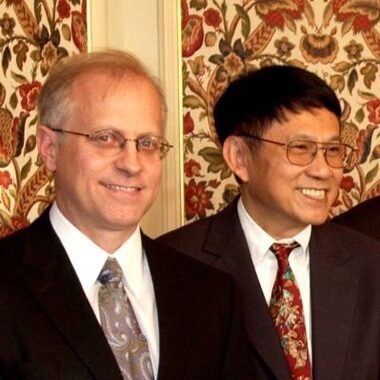R. Hemley: discours de remerciement – Berne, 11.11.2005 (anglais)
États-Unis - États-Unis/Chine
Russell Hemley et Ho-kwang Mao
Prix Balzan 2005 pour la physique des minéraux
Pour le remarquable impact de leurs travaux qui ont conduit à des progrès fondamentaux, tant sur le plan théorique qu’expérimental, dans le domaine des minéraux soumis à des conditions physiques extrêmes. Formant un groupe de travail extrêmement efficace, Russell Hemley et Ho-kwang Mao ont contribué pendant vingt ans à la recherché au plus haut niveau. Ils ont mis au point des techniques permettant d’étudier le comportement d’une vaste gamme de matériaux, parmi lesquels l’hydrogène, le “minéral” le plus abondant dans l’univers. Les résultats de leurs recherches ont apporté une contribution fondamentale à notre compréhension de la nature.
Mr. Federal Councillor,
Balzan Foundation Committee Members,
Ladies and Gentlemen,
I wish to thank the International Balzan Foundation for this special honor. Dave Mao and I are especially pleased that the award recognizes for the first time the field of mineral physics, and our area of research into the nature of matter under extreme pressures and temperatures. Though new, the discipline has roots in the dawn of modern science, dating back to the attempts of the Accademia del Cimento of Florence in the 1660s to determine if water is compressible. During the past several decades, the field has emerged at the interface between physics and mineralogy, a discipline in which the thermodynamic variable of pressure plays a central role. The field is driven by the question of the structure, composition, and evolution of the Earth from its crust to its core. The key finding is that the behavior of matter within planets as a whole is far different from what we’ve learned about materials at the Earth’s surface. This research has led to new findings in not only minerals but in planetary fluids such as water, which in large measure controls the dynamics and evolution of planetary bodies, and in gases such as hydrogen, the most abundant “mineral” in the visible universe. As such, the field encompasses all of the planets of our solar system, as well as newly discovered astrophysical objects beyond.
But the field is impacting areas beyond this. In the early days of quantum mechanics, it was proposed that all materials must become metals if compressed enough, a conjecture that has led experimentally to the discovery of new metals, superconductors, and novel electronic materials. The research is leading to new views of chemistry, including a new Periodic Table of the Elements that takes into account the dramatic effects of pressure on chemical reactivity and electronic structure. This research has led to new ways of synthesizing materials: one example, diamond, may lay the groundwork for numerous advanced technologies of the 21st century. New studies of organic systems under extreme conditions give insight into the origin and evolution of life, experiments that may open new directions in molecular biology and genetics.
The discipline being honored thus represents a synthesis of many fields, indeed a new dimension in the sciences. We are indeed grateful for the prescience of the International Balzan Foundation to recognize this emerging area of inquiry. Our field has grown into a truly international effort: a key to its success has been the development of a new generation of X-ray, neutron, and other large facilities throughout the world available to a growing community of scientists. As the Balzan Prize honors the scholarship broadly, it is a pleasure to see our field placed among other more established fields of learning worldwide.
Upon entering college I pursued philosophy but quickly realized that despite its special role in western thought, it is in many ways the handmaiden of science, its problems dependent on the prevailing scientific world view. Thus a quicker way to understanding would be through science itself; and I chose chemistry, a springboard to the other sciences. In the end, I had the great fortune to have landed where I am now, and I realize that many others could just as easily be standing here today. I’ve been privileged to have worked with many inspiring scientists during my undergraduate, graduate, and post-graduate years, culminating in the partnership with Dave Mao at the Carnegie Institution. Also important are the many talented students, post-doctoral fellows, and other colleagues with whom I’ve worked and continue to learn – and of course my family whom I cherish and who teach and support me in untold ways.
The Carnegie Institution, much like the Balzan Foundation, was founded to encourage “investigation, research, and discovery,” and “the application of knowledge for the improvement of mankind.” The freedom the Institution has provided has been crucial to the development of this interdisciplinary field. We are especially pleased by the Foundation’s focus on training the next generation of researchers. The Accademia del Cimento was closed after only a decade of existence, despite its magnificent productivity. In our own times the quest for understanding likewise encounters periods of difficulty if not darkness. In a span of ten short years, the Accademia lit a spirit of inquiry that became a touchstone for modern science. Visionary institutions like the Balzan Foundation celebrate and preserve this noble tradition. Thank you once again.
